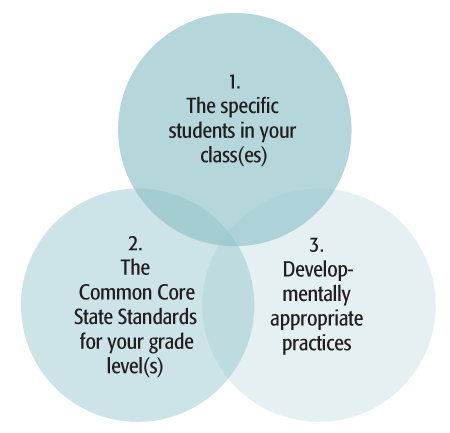A teacher educator offers advice on adopting and adapting the Common Core.
When the Common Core first appeared, circa 2009, I spent a great deal of time fretting about it. I didn’t like the top-down approach taken by the expert panels assembled to craft the standards in English language arts and mathematics. I didn’t like their secrecy, and I didn’t like the absence of teachers or scholars with expertise in early childhood education on their expert panels. Most important, I believed that many of the standards for grades K-2 might be developmentally inappropriate for young children.
By 2012, I’d stopped fretting. At the time, the Common Core State Standards had been adopted by 44 states, and public school teachers in those states were required to teach to them — whether they liked them or not. As a teacher educator in California, my job was to engage teaching credential candidates in conversations about how to interpret and implement those standards, not to raise concerns about them.
As it turned out, my concerns went away all on their own. Over time, I found myself embracing the standards as it became clear that they made positive contributions to my work as a teacher educator.
Three essential elements
I’ve found that in order to teach the Common Core effectively, educators must create academic experiences that weave together three key elements: the needs of the given students, the particular standards to be learned, and attention to developmentally appropriate practices. All three are equally critical.

#1. Focus on your students first.
An effective lesson or curriculum unit should begin with thoughtful consideration of the needs of the specific students in your class. The standards in the Common Core do not require a particular pedagogy. Each one can be taught in many different ways, which means that teachers have a lot of leeway to choose classroom experiences and activities that tap the interests, skills, or curiosities of the specific students in the class, turning a solid lesson into something much more engaging and memorable.
#2. Pick only the most important standards.
Teachers are expert at shoehorning a variety of standards into a single lesson, covering as much content as possible. This may seem reasonable, given the specter of high-stakes tests looming in everyone’s minds. However, those marginally related standards often distract students and pull their attention away from the real meat of the lesson or unit. It’s more effective to select the most relevant standards, hit them hard, and then move on.
#3. Teach the content in developmentally appropriate ways.
Despite my initial skepticism, I came to see that the knowledge and skills in the Common Core are set at age-appropriate levels of challenge, at least on paper. For example, the 2nd-grade standards reflect the capabilities of typically developing 7- and 8-year-old children. However, what is “age-appropriate,” on average, will be too difficult for some students and too easy for others. Thus, while the long-term goal should be to help all students meet the standards, teachers must have the flexibility to adapt and tweak their lessons to ensure that every student is learning every day.
The Common Core’s future
Is the Common Core perfect? No. Did teachers take to these new standards eagerly? Not really. But teachers in 35 states still use the Common Core as the foundational set of knowledge and skills their students must master. And many teachers who have worked with the Common Core over a number of years have come to see that it provides a trustworthy, clear, and carefully sequenced set of standards upon which they can draw, helping them frame challenging and achievable lessons for their students in English language arts and mathematics.
Not all of today’s teachers might use those standards exactly as the authors of the Common Core envisioned (i.e., to define a single, comprehensive set of goals for learning at each grade level). But teachers do use them as an important resource. Just as they might reach for a dictionary to look up the precise meaning of a word, teachers might refer to their copies of the standards to make sure their instructional plans are on point. From what I’ve seen, the Common Core State Standards have transcended their initial purposes and become both a reference volume and a touchstone for instructional planning for all teachers.
Originally published in March 2017 Phi Delta Kappan 98 (6), 80. © 2017 Phi Delta Kappa International. All rights reserved.
ABOUT THE AUTHOR

Lisa S. Goldstein
LISA S. GOLDSTEIN is a professor of education at Santa Clara University, Santa Clara, Calif. She is the author of Using Developmentally Appropriate Practices to Teach the Common Core, Grades PreK-3 .










